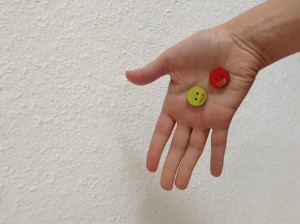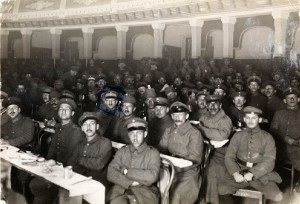An Interview with Lina Khesina
30 July 2014 is International Friendship Day. But how do we commemorate friendship? Or how do we make it visible? We consulted with communications designer Lina Khesina to find out. She devised a pair of ‘friendship buttons’ that you can get at the moment from the art vending machine in our permanent exhibition. One of them features the word “Tsemed” in Hebrew script, and the other one the word “Chemed.”

The buttons “Tsemed” and “Chemed”.
Photo courtesy of the artist
Lisa Albrecht: Lina, why did you develop this item in particular for the art vending machine?
I had the idea of showing the beauty of the Hebrew language and transmitting it in an everyday way. I don’t actually speak Hebrew myself, but purely from a musical perspective I find it and Spanish the two most beautiful languages. So I really wanted to discover Hebrew for myself and find a constellation of words in the language that I could play with. That’s how these buttons with the wordplay emerged.
How did the wordplay occur to you?
In Russian, best friends are often called “nje rasléj wodá”, which more or less means “even water cannot destroy this bond.” I did some research on whether there’s such an idiom in Hebrew as well and thus learned about “Tsemed Chemed.” Translated literally, it means “sweet entanglement” or “fine pair”, and is an expression for ‘close friends.’
What do these two words have to do with the buttons?
Buttons get sewed on with a thread and become then ‘entangled,’ or interwoven, with the material. Close friends experience something similar, even when they live thousands of kilometers apart. Like the buttons, they’re connected to each other by the thread and the adage. → continue reading
The Festival of Liberation at the Front
Yesterday evening, Monday, 14 April 2014, was the start of the eight-day Passover festivities. These kick off each year with the first Seder, the name of which derives from the Hebrew word seder, meaning order, because a particular ritual sequence is observed the entire evening.
The ritual Seder program is laid down in the Haggadah, an often beautifully illustrated book. (Incidentally, some especially precious Haggadot are currently on display in our special exhibition “The Creation of the World” and our director of archives recently described in his blog why even a nondescript Haggadah might be of great value to a museum.) Traditional texts and songs are recited from the Haggadah. Symbolic dishes and drinks deck the tables, ready to be consumed at specific moments during the evening.

German soldiers celebrate Passover in the occupied town of Jelgava (near Riga). © Jewish Museum Berlin, photo: anonymous. Donated by Lore Emanuel
But why is this night different from all other nights? This is a question that Jews all over the world ask themselves year after year at the Seder dinner. The answer is: it is the festival of liberation, for it commemorates the Israelites’ exodus from slavery in ancient Egypt. Everyone is supposed to feel, each year, as if she or he personally is about to leave Egypt. As a token of tribute to this new-won freedom, people comfortably recline while eating and drinking—for to take this position was the prerogative solely of free individuals in antiquity, not of slaves. → continue reading
Interview with Alexis Hyman Wolff

Alexis Hyman Wolff in her exhibition Zur Zeit at the Museum der Dinge, Berlin, June 2013.
Photo courtesy of the artist.
One of the works in our art vending machine is a candle shaped like a root, made by the artist and curator Alexis Hyman Wolff. In this interview, she offers insight into the development of the work:
Christiane Bauer: Why did you make a candle for the art vending machine?
Alexis Hyman Wolff: Thinking about the small size of the objects and the temporary home they would find in the vending machine, I wanted to reflect on the idea of the souvenir, a central theme in museums. Candles are used for memorial in many cultures. In Jewish tradition, a yortsayt candle is lit to remember a loved one on the anniversary of their death.
What is special about the material you used?
The candles are made out of beeswax from a beekeeping supplier in Berlin. I understand that beeswax is one of the few materials that burn without producing black smoke, which could explain the belief that burning beeswax candles is good for the air. According to a European folk custom, when someone dies, a member of the family must go to the hive and “tell the bees,” and also invite them to the funeral. This tradition suggests a link between bees and the spirit world.
How important is the aspect of “remembrance” in your work? → continue reading


